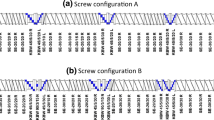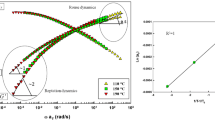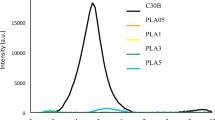Abstract
In this work, the rheological behaviour of high molecular mass polyamide 6 (PA6)/organo-montmorillonite nano-composites, obtained via melt blending, was investigated under shear and extensional flow. Capillary rheometry was used for the measurement of high shear rate steady state shear viscosity and die entrance pressure losses; further, by the application of a converging flow method (Cogswell model) to these experimental results, elongational viscosity data were indirectly calculated. The extensional behaviour was directly investigated by means of melt spinning experiments, and data of apparent elongational viscosity were determined. The results evidenced that the presence of the organo-clay in filled PA6 melts modifies the rheological behaviour of the material, with respect to the unfilled polymer, in dependence on the type of flow experienced by the fluid. In shear flow, the nano-composites showed a slightly lower viscosity than neat PA6, whereas in elongation, they appeared much more viscous, in dependence on the organo-clay content.












Similar content being viewed by others
Abbreviations
- a :
-
stretching acceleration (mm/s2)
- a T :
-
shift factor for the application of the time-temperature superposition principle
- d :
-
diameter of the die (mm)
- D :
-
diameter of the barrel (mm)
- DR:
-
draw ratio, defined as the ratio of the stretching velocity (\({v}_{s}\)) to the die extrusion velocity (\({v}_{0}\))
- E 0 :
-
viscous flow activation energy (kJ/mol)
- F :
-
force exhibited by the polymer filament in resisting extension during a melt spinning test (cN)
- GR:
-
gearbox rating of the extruder used in compounding operation (N·m)
- k :
-
consistency in the apparent shear viscosity power-law equation (\(\eta_{\rm sh,a} = k\cdot {\dot{\gamma}_{\rm app}^{n-1}}\)), (Pa·sn)
- l :
-
length of the capillary (mm)
- L :
-
length of the spinline (mm)
- n :
-
exponent in the apparent shear viscosity power-law equation (\(\eta_{\rm sh,a} = k\cdot {\dot{\gamma}_{\rm app}^{n-1}}\))
- \({{\kern2pt}\dot{{\kern-2pt}M}}\) :
-
feed rate in compounding operation (kg/h)
- N :
-
screw speed of the extruder in compounding operation (RPM)
- Q :
-
volume flow rate (mm3/s)
- R :
-
gas constant, R = 8.315 ·10 − 3 kJ/(mol·K)
- T :
-
temperature (°C)
- T 0 :
-
reference temperature for the construction of the master curve of η sh,app (°C)
- \({v}_{\rm s}\) :
-
stretching velocity (at the stretching wheels) (\({v}_{\rm s} ={v}_0 +a\cdot t\)), (mm/s)
- \({v}_{0}\) :
-
extrusion velocity in the capillary (\({v}_0 =\frac{Q}{\frac{\pi}{4}\cdot d^2}\)), (mm/s)
- \({\dot{\gamma}}\) :
-
(true) shear rate at the die wall determined by the application of the Rabinowitsch–Weissenberg method (s − 1)
- \({\dot{\gamma}_{\rm app}}\) :
-
apparent shear rate at the die wall (\({\dot{\gamma}_{\rm app}} = \frac{32\cdot Q}{\pi \cdot d^3}\)) (s − 1)
- \(\mathit{\Delta} \eta_{\rm el,r}\) :
-
relative extensional viscosity increase for a polymer suspension with respect to the unfilled polymer, for a fixed elongational strain rate
- \(\mathit{\Delta} P_{\rm ent}\) :
-
pressure losses localised at the die entrance (Pa)
- ε dr :
-
elongational strain experienced by a polymer filament during the drawing process in a melt spinning experiment
- \({{\kern1pt}\dot{{\kern-1pt}\varepsilon}}\) :
-
elongational strain rate (s − 1)
- η el :
-
elongational viscosity (Pa·s)
- η el,app :
-
apparent elongational viscosity determined from melt spinning experiments (Pa·s)
- η sh :
-
(true) shear viscosity, defined as the ratio of the true shear stress (τ), corrected for entrance pressure drops (\(\mathit{\Delta} P_{\rm ent}\)), to the true shear rate (\({\dot{\gamma}}\)), (Pa·s)
- η sh,a :
-
apparent shear viscosity, defined as the ratio of the true shear stress (τ), corrected for entrance pressure drops (\(\mathit{\Delta} P_{\rm ent}\)), to the apparent shear rate (\({\dot{\gamma}_{\rm app}}\)), (Pa·s)
- η sh,app :
-
apparent shear viscosity, defined as the ratio of the apparent shear stress (τ app), uncorrected for entrance pressure drops (\(\mathit{\Delta} P_{\rm ent}\)), to the apparent shear rate (\({\dot{\gamma}_{\rm app}}\)), (Pa·s)
- τ :
-
(true) shear stress at the die wall, corrected for entrance pressure drops (\(\mathit{\Delta} P_{\rm ent}\)), (Pa)
- τ app :
-
apparent shear stress at the die wall, uncorrected for entrance pressure drops (\(\mathit{\Delta} P_{\rm ent}\)), (Pa)
- %T :
-
torque fraction used in compounding operation (%)
References
Aharoni SM (1980) Rigid backbone polymers, 17: solution viscosity of polydisperse systems. Polymer 21:1413–1422
Alexandre M, Dubois P (2000) Polymer-layered silicate nanocomposites: preparation, properties and uses of a new class of materials. Mat Sci Eng R 28:1–63
Ayyer RK, Leonov AI (2004) Comparative rheological studies of polyamide-6 and its low loaded nanocomposite based on layered silicates. Rheol Acta 43:283–292
Azaiez J, Guenette R, Ait-Kadi A (1997) Investigation of the abrupt contraction flow of fiber suspensions in polymeric fluids. J Non-Newton Fluid Mech 73:289–316
Baldi F, Bignotti F, Riccò T (2006) Rheological behaviour of nano- and micro-composites based on polyamide 6. Presented at 2nd Nanofun-Poly International Symposium on Nanostructured and Functional Polymer-Based Materials and Composites, May 29–31 2006, Villeurbanne, Lyon (FR)
Baldi F, Franceschini A, Riccò T (2007) Determination of the elongational viscosity of polymer melts by melt spinning experiments. A comparison with different experimental techniques. Rheol Acta 46:965–978
Binding DM (1988) An approximate analysis for contraction and converging flows. J Non-Newton Fluid Mech 27:173–189
Binding DM (1991) Further considerations of axisymmetric contraction flows. J Non-Newton Fluid Mech 41:27–42
Binding DM, Couch MA, Walters K (1998) The pressure dependence of the shear and elongational properties of polymer melts. J Non-Newton Fluid Mech 79:137–155
Cho JW, Paul DR (2001) Nylon 6 nanocomposites by melt compounding. Polymer 42:1083–1094
Cogswell FN (1972) Converging flow of polymer melts in extrusion dies. Polym Eng Sci 12:64–73
Davis RD, Gilman JW, VanderHart DL (2003) Processing degradation of polyamide 6/montmorillonite clay nanocomposites and clay organic modifier. Polym Degrad Stab 79:111–121
Fornes TD, Yoon PJ, Keskkula H, Paul DR (2001) Nylon 6 nanocomposites: the effect of matrix molecular weight. Polymer 42:9929–9940
Fornes TD, Yoon PJ, Paul DR (2003) Polymer matrix degradation and color formation in melt processed nylon 6/clay nanocomposites. Polymer 44:7545–7556
Gibson AG (1989) Die entry flow of reinforced polymers. Composites 20:57–64
Gotsis AD, Ke Q (1999) Comparison of three methods to measure the elongational viscosity of polymer melts: entry flow, fiber spinning and uniaxial elongation. Presented at SPE ANTEC 1999, New York
Gotsis AD, Odriozola A (1998) The relevance of entry flow measurements for the estimation of extensional viscosity of polymer melts. Rheol Acta 37:430–437
Gotsis AD, Odriozola A (2000) Extensional viscosity of a thermotropic liquid crystalline polymer. J Rheol 44:1205–1223
Hotta S, Paul DR (2004) Nanocomposites formed from linear low density polyethylene and organoclays. Polymer 45:7639–7654
Khanna YP, Han PK, Day ED (1996) New developments in the melt rheology of nylons. I: effect of moisture and molecular weight. Polym Eng Sci 36:1745–1754
Krishnamoorti R, Giannelis EP (1997) Rheology of end-tethered polymer-layered silicate nanocomposites. Macromolecules 30:4097–4102
Krishnamoorti R, Ren J, Silva AS (2001) Shear response of layered silicate nanocomposites. J Chem Phys 114:4968–4973
La Mantia FP, Tzankova Dintcheva N (2006) Eva copolymer-based nanocomposites: rheological behaviour under shear and isothermal and non-isothermal elongational flow. Polym Test 25:701–708
Laun HM (1984) Orientation effects and rheology of short glass fiber-reinforced thermoplastics. Colloid Polym Sci 262:257–269
Laun HM, Schuch H (1989) Transient elongational viscosities and drawability of polymer melts. J Rheol 33:119–175
Magda JJ, Baek S-G, De Vries KL, Larson RG (1991) Shear flows of liquid-crystal polymers: measurements of the 2nd normal stress difference and the Doi molecular theory. Macromolecules 24:4460–4468
Mobuchon C, Carreau PJ, Heuzey M-C, Sepehr M, Ausias G (2005) Shear and extensional properties of short glass fiber reinforced polypropylene. Polym Compos 26:247–264
Prasad R, Pasanovic-Zujo V, Gupta RK, Cser F, Bhattacharya SN (2004) Morphology of EVA based nanocomposites under shear and elongational flow. Polym Eng Sci 44:1220–1230
Rauwendaal C (2001) Polymer extrusion. Hanser, Munich
Tanner RI, Walters K (1998) Rheology: an historical perspective. Elsevier, Amsterdam
Tjong SC (2006) Structural and mechanical properties of polymer nanocomposites. Mat Sci Eng R 53:73–197
Tung J, Gupta RK, Simon GP, Edward GH, Bhattacharya SN (2005) Rheological and mechanical comparative study of in situ polymerized and melt-blended nylon 6 nanocomposites. Polymer 46:10405–10418
Wagner MH, Collignon B, Verbeke J (1996) Rheotens-mastercurves and elongational viscosity of polymer melts. Rheol Acta 35:117–126
Wang KH, Xu M, Choi YS, Chung IJ (2001) Effect of aspect ratio of clay on melt extensional process of maleated polyethylene/clay nanocomposites. Polym Bull 46:499–505
Xie W, Gao Z, Pan W-P, Hunter D, Singh A, Vaia R (2001) Thermal degradation chemistry of alkyl quaternary ammonium montmorillonite. Chem Mater 13:2979–2990
Acknowledgements
The authors are grateful to Dr. M. Grosso and Ing. M. Bronzoni of Ceast SpA (Pianezza, Torino, Italy) for the capillary rheometer kindly placed at their disposal and to Dr. A. Filippi and Dr. C. Armanni of Radici Novacips SpA (Chignolo d’Isola, Bergamo, Italy) for the materials kindly supplied.
Author information
Authors and Affiliations
Corresponding author
Rights and permissions
About this article
Cite this article
Baldi, F., Franceschini, A., Bignotti, F. et al. Rheological behaviour of nano-composites based on polyamide 6 under shear and elongational flow at high strain rates. Rheol Acta 48, 73–88 (2009). https://doi.org/10.1007/s00397-008-0315-y
Received:
Revised:
Accepted:
Published:
Issue Date:
DOI: https://doi.org/10.1007/s00397-008-0315-y




